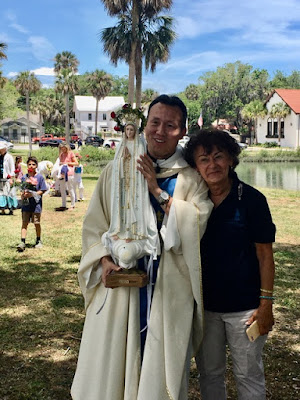 |
| Front Door of the Church of Sts. Jeremiah and Lucy La Chiesa dei Ss. Geremia e Lucia, Venice, Italy |
 |
| Remains of St. Lucy, Virgin and Martyr Church of Sts. Jeremiah and Lucy, Venice, Italy In 2018, my husband and I went to Italy. It wasn't our first time, but as you know there is so much to see and do in Italy. You can go back many times and not exhaust seeing and enjoying the beautiful country with its Catholic history. St. Lucy has been one of my favorite saints for many years. She is an Advent saint, and I love the season of Advent, the season of waiting and preparing for Christmas. The season of waiting for the birth of Christ is one many of us take quite awhile to learn well. St. Lucy learned at a very young age to be Christ centered. She gave her life for Christ both in pledging her virginity to Him and then suffering martyrdom in Sicily in 303 AD rather than honor the Roman gods. See my blog post St. Lucy Recently we were able to return to Venice for a half day visit. It was then that we went to The Church of Santi Geremia e Lucia to venerate her remains and to learn a bit more about this young saint. Born in Syracuse, Sicily, in 283, Lucy was beloved by the people. After her martyrdom, her body remained in Syracuse until the Arab invasion of 878 when it was hidden away for fear it would be desecrated. From 1040 to 1204, it was honored in Constantinople. In 1204 when the Venetians conquered Constantinople, they moved the saint's body to Venice. Between 1204 and 1609, St. Lucy's remains were to be found in various Venetian churches. They were moved from one church to another for different reasons, finally resting in a church named after her, Santa Lucia, with an associated monastery. In 1845, a spot for a new train station was being contemplated in Venice, and it was in the area where Saint Lucy's remains rested that the station was to be built. A number of buildings were torn down to make room for the station. The Church of Santa Lucia remained untouched, but eventually it was determined due to the noise of the trains and the deterioration of the church building that it, too, must be torn down. It caused great consternation among the faithful. To acknowledge the great devotion of the faithful, the train station was named Santa Lucia and a commemorative stone with an engraved picture of the former church and an inscription were placed in the center of the train station floor. The question, of course, was where to put the venerated remains of St. Lucy. Much consideration was given and on July 5, 1860, the Patriarch of Venice, Angelo Francesco Ramazzotti, sent a letter to the faithful explaining the Church of St. Jeremiah, Chiesa San Geremia, was chosen for the honor and a beautiful chapel would be built to house her remains. On July 11, 1860, the transfer of St. Lucy's remains took place in great solemnity and were placed above the high altar until the chapel was completed in 1863, There is a great deal of architectural history and conversation regarding the Chapel of St. Lucy which I am not going into in this little write-up. What I would like to leave you with is the simple fact that for centuries the faithful in Sicily, in Byzantium, Sweden, Venice, and elsewhere have been inspired by the deep and courageous faith of this young virgin and martyr to the point of protecting her remains that they might be honorably venerated. The body of St. Lucy has been allowed by God to remain incorrupt. You can see her feet in the picture above that I took in October 2022. Her head has a silver mask over it and her body is covered by a red garment. In an earlier writing, I mistakenly said St. Lucy was stabbed to death, but it seems rather that she was decapitated. In fact, unfortunately, on November 7, 1981, her body but not her head was stolen from the Chapel of Saint Lucy in Venice. Many prayers were offered for its return. During the night of December 12 to December 13, 1981, the Venetian police found the body of St. Lucy and returned it to the Church of Saints Jeremiah and Lucy in time for her feast day! I hope you have a chance to go to Venice some day and to visit the Chiesa dei Ss. Geremia and Lucia and venerate her remains. Whether you are able to go or not, be sure to ask her to intercede for your intentions, help you to prepare well for Christmas, and grant you and all your loved ones the gift of healthy eyes. St. Lucy is the patron saint of eyes. St. Lucy, Pray for Us! Below is a picture of a yummy bread, Luciakrona, Lucia Crown, that I make every year for her feast day along with the fun St. Lucy Eyeballs treats! You can find the recipes for these items in my book Celebrating Advent and Christmas with Children, pages 65 and 69. The Eyeball treat recipe is on my blog. See the link above. Enjoy! There are many good children's books about St. Lucy. Here is just one that I recommend. You will find others in your Catholic books stores, publishers, and on Amazon. The resource I used in writing this blog post is La Chiesa dei Ss. Geremia e Lucia by Pala Bin. |




.jpg)

.JPG)
.JPG)










.jpg)





.jpg)










